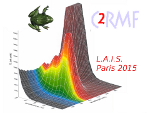In recent years the application of retrospective dosimetry using quartz extracted from mortar has been developed since Bøtter-Jensen et al. (2000) discovered that mortar is bleached to a considerable degree during manufacturing and thus it is suitable to be used as a dosimeter. After that some attempts were made in order to estabilish reliable OSL dating protocols (Urbanova et al. 2015, Panzeri, 2013, Goedicke, 2011, Gueli et al., 2010). Mortar dating is in fact unquestionably a better tool for the chronology of buildings than brick because it is made shortly before its use and it is not recyclable, hence it correspond to the time of the construction. Even though, mortar dating by Optically Stimulated Luminescence (OSL) has not become a routine method and its application to samples of known age must be carried out to establish the best measurement protocols.
Earthen mortars from Cremona (Northern Italy) are suitable for OSL due to their high quartz content (Cantù et al. (2015). Four mortar samples from Palazzo Soldi (late XVIII century) and seven mortar samples from Palazzo Raimondi (late XV century) were analysed. Moreover it was possible to sample “sandwiches” of bricks still stick together with the original mortar.
Dose recovery preheat tests were carried out before OSL measurement in order to evaluate which were the best conditions of preheat temperatures. OSL measurements were performed using the single aliquot regeneration (SAR) protocol (Murray and Wintle, 2000, 2006). Equivalent doses (De) were obtained both on small multi-grain aliquots and on single-grain with the purpose of compare the data and determine which method gives the best results. Data were then treated using the statistical approach proposed by Galbraith et al. (1999) and by Roberts et al. (2000).
Data obtained by small multi-grain aliquots and single-grain aliquots are both highly dispersed (the former less than the latter), which indicates that the samples were not well-bleached during their last exposure to sunlight. The mortars ages estimated from small multi-grain aliquots are higher than expected. So the Minimum Age Model was applied in oder to find and select grains that were completely emptied by sunlight during the preparation of mortar. Only for a few samples this model gives good results. In order to obtain reliable results also the Finite Mixture Model was used. The results obtained are compared and discussed.
References:
Bøtter-Jensen, L., Solongo, S., Murray, A.S., Banerjee, D., Jungner, H. (2000) Using the OSL single-aliquot regenerative-dose protocol with quartz extracted from building materials in retrospective dosimetry, Radiation Measurements, 32, 841–845.
Cantù M., Giacometti F., Landi A., Riccardi M.P., Tarantino S.C., Grimoldi A. (2015) Characterization of XVIIIth century earthen mortars from Cremona (Northen Italy): insights on a manufacturing tradition, Materials Characterization, 103, 81-89.
Murray A.S. and Wintle A.G. (2000) Luminescence dating of quartz using an improved single-aliquot regenerative-dose protocol, Radiation Measurements, 32, 57-73.
Murray A.S. and Wintle A.G. (2003) The single aliquot regenerative dose protocol: Potential for improvements in reliability, Radiation Measurements, 37, 377-381.
Galbraith R.F., Roberts R.G., Laslett G.M., Yoshida H., Olley J.M. (1999) Optical dating of single and multiple grains of quartz from Jinmium rock shelter, northern Australia: Part I, experimental design and statistical models, Archaeometry, 41, 339-364.
Goedicke C. (2011). Dating historical calcite mortar by blue OSL: results from known age samples, Radiation Measurements, 37, 409-415.
Panzeri L. (2013). Mortar and surface dating with Optically Stimulated Luminescence (OSL): Innovative techniques for the age determination of buildings. Il Nuovo Cimento, vol. 36C, N. 4
Roberts R.G., Galbraith R.F., Yoshida H., Laslett G.M., Olley J.M. (2000) Distinguishing dose populations in sediment mixtures: A test of single-grain optical dating procedures using mixtures of laboratory-dosed quartz, Radiation Measurements, 32, 459-465.
Urbanova P., Hourcade D., Ney C and Guibert P. (2015). Sources of uncertainties in OSL dating of archaeological mortars: The case study of the Roman amphitheatre "Palais-Gallien" in Bordeaux. Radiation Measurements,72, 100-110.

 PDF version
PDF version
